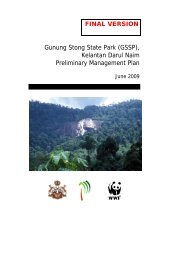Reef Status of Semporna Priority Conservation ... - WWF Malaysia
Reef Status of Semporna Priority Conservation ... - WWF Malaysia
Reef Status of Semporna Priority Conservation ... - WWF Malaysia
Create successful ePaper yourself
Turn your PDF publications into a flip-book with our unique Google optimized e-Paper software.
Discussion<br />
In general, the surveys indicate that most <strong>of</strong> the reefs are over-exploited and stressed by<br />
fishing activities. The reefs <strong>of</strong> the Southern and Northern islands have similar hard coral<br />
cover. There are no reefs with coral cover which falls in the excellent category, and the<br />
majority <strong>of</strong> surveyed reefs fall in the poor and fair categories with less than 50% hard<br />
coral cover. This can be partly attributed to potentially low natural coral cover or is<br />
indicative <strong>of</strong> human impacts on the reefs.<br />
Important observations from some <strong>of</strong> the indicator species merit special attention. There<br />
was no humphead wrasse (Cheilinus undulatus) observed during the surveys. The sole<br />
populations <strong>of</strong> humphead wrasse in <strong>Semporna</strong> are found on the reefs <strong>of</strong> Sipadan which<br />
are protected from fishing and destructive fishing practices by the presence <strong>of</strong> Sabah<br />
Parks and divers. Additionally, very few grouper (Serranidae) were observed during the<br />
surveys. These results indicate overfishing <strong>of</strong> these commercially and ecologically<br />
important species.<br />
During the invertebrate observations, it was found that 99% <strong>of</strong> all invertebrates were<br />
Diadema sea urchins. Diadema are also concentrated on some reefs and largely absent on<br />
others. This can indicate pressures on those reefs that promote Diadema populations or a<br />
lack <strong>of</strong> natural predators.<br />
Some areas in <strong>Semporna</strong> benefit from de facto local based management protection<br />
systems such as those enforced by dive resorts. The reefs around Mabul appear, from<br />
anecdotal evidence, to be recovering from years <strong>of</strong> blast fishing. The resorts on Mabul<br />
have been limiting bomb fishing for many years, and engaging in conservation and coral<br />
replanting activities. However, the anthropogenic pressure on the reefs has shifted from<br />
fishing activities to tourism activities which can lead to other stresses such as pollution<br />
and reef damage caused by negligent divers and snorkelers.<br />
Based on the comparison <strong>of</strong> recent and previous surveys, there appears to be some<br />
possible improvement in the condition <strong>of</strong> the reefs in some areas. For example, average<br />
coral cover in Ligitan Island was 18.7% before (Pilcher & Cabanban 2000), and the<br />
recent survey <strong>of</strong> Ligitan reefs showed that average coral cover has slight increased to<br />
20%. Likewise, average coral cover in Mabul Island increased from 15.8% (Pilcher &<br />
Cabanban 2000) to 17.6 % (Aw 2007). Besides this, Kapalai Island with its resort that<br />
started operating since February 1998 has significant improvement <strong>of</strong> coral cover from<br />
17.9% to 27% (Pilcher & Cabanban 2000). The improvement in condition <strong>of</strong> reefs can be<br />
expected in some areas due to the conservation efforts from the tourism sector. The<br />
conditions <strong>of</strong> reefs will further improve if more management efforts are implemented and<br />
existing regulations are better enforced.<br />
<strong>Semporna</strong> requires regular monitoring <strong>of</strong> all reef areas to inform management decisions.<br />
Monitoring should be done collaboratively with responsible management agencies, the<br />
tourism sector and local communities to follow the common vision for <strong>Semporna</strong> and to<br />
promote an interest in managing <strong>Semporna</strong>’s marine resources for sustainability. This<br />
first report provides a baseline for future monitoring and tracking <strong>of</strong> resource trends in<br />
the area.<br />
12
















